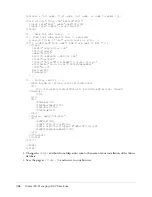
482
Chapter 23: Managing LDAP Directories
Attribute type
A schema’s attribute type specification defines the following properties:
•
The attribute type name
•
A unique object ID that identifies the attribute type
•
(Optional) An indication of whether the type is single-valued or multivalued (the default is
multivalued)
•
The attribute syntax and matching rules (such as case sensitivity)
The attribute type definition can also determine limits on the range or size of values that the type
represents, or provide an application-specific usage indicator. For standard attributes, a registered
numeric ID specifies the syntax and matching rule information. For more information on
attribute syntaxes, see ETF RFC 2252 at http://www.ietf.org/rfc/rfc2252.txt.
Operational attributes
, such as creatorsName or modifyTimeStamp, are managed by the directory
service and cannot be changed by user applications.
Using LDAP with ColdFusion
The
cfldap
tag extends the ColdFusion query capabilities to LDAP network directory services.
The
cfldap
tag lets you use LDAP in many ways, such as the following:
•
Create Internet White Pages so users can locate people and resources and get information
about them.
•
Provide a front end to manage and update directory entries.
•
Build applications that incorporate data from directory queries in their processes.
•
Integrate applications with existing organizational or corporate directory services.
The
cfldap
tag
action
attribute supports the following operations on LDAP directories:
The following table lists the attributes that are required and optional for each action. For more
information on each attribute, see
cfldap
in
CFML Reference
.
Action
Description
query
Returns attribute values from a directory.
add
Adds an entry to a directory.
modify
Adds, deletes, or changes the value of an attribute in a directory entry.
delete
Deletes an entry from a directory.
modifyDN
Renames a directory entry (changes its distinguished name).
Action
Required attributes
Optional attributes
query
server, name, start,
attributes
port, username, password, timeout, secure, rebind,
referral, scope, filter, sort, sortControl startRow,
maxRows, separator, delimiter
add
server, dn, attributes
port, username, password, timeout, secure, rebind,
referral, separator, delimiter
modify
server, dn, attributes
port, username, password, timeout, secure, rebind,
referral, modifyType, separator, delimiter
Summary of Contents for ColdFusion MX
Page 1: ...Developing ColdFusion MX Applications...
Page 22: ...22 Contents...
Page 38: ......
Page 52: ...52 Chapter 2 Elements of CFML...
Page 162: ......
Page 218: ...218 Chapter 10 Writing and Calling User Defined Functions...
Page 250: ...250 Chapter 11 Building and Using ColdFusion Components...
Page 264: ...264 Chapter 12 Building Custom CFXAPI Tags...
Page 266: ......
Page 314: ...314 Chapter 14 Handling Errors...
Page 344: ...344 Chapter 15 Using Persistent Data and Locking...
Page 349: ...About user security 349...
Page 357: ...Security scenarios 357...
Page 370: ...370 Chapter 16 Securing Applications...
Page 388: ...388 Chapter 17 Developing Globalized Applications...
Page 408: ...408 Chapter 18 Debugging and Troubleshooting Applications...
Page 410: ......
Page 426: ...426 Chapter 19 Introduction to Databases and SQL...
Page 476: ...476 Chapter 22 Using Query of Queries...
Page 534: ...534 Chapter 24 Building a Search Interface...
Page 556: ...556 Chapter 25 Using Verity Search Expressions...
Page 558: ......
Page 582: ...582 Chapter 26 Retrieving and Formatting Data...
Page 668: ......
Page 734: ...734 Chapter 32 Using Web Services...
Page 760: ...760 Chapter 33 Integrating J2EE and Java Elements in CFML Applications...
Page 786: ...786 Chapter 34 Integrating COM and CORBA Objects in CFML Applications...
Page 788: ......
















































